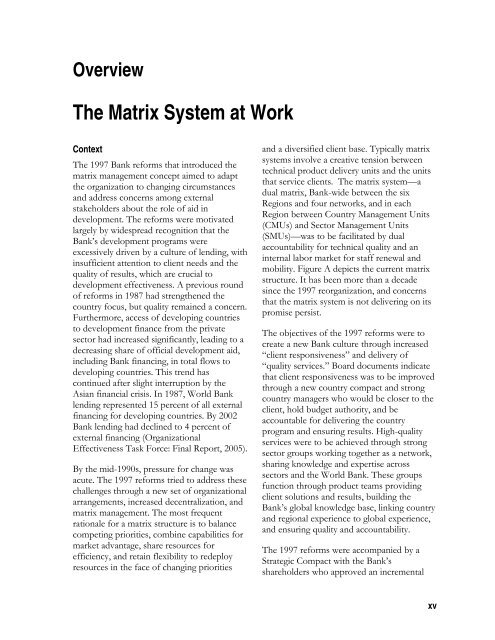The Matrix System at Work - Independent Evaluation Group - World ...
The Matrix System at Work - Independent Evaluation Group - World ...
The Matrix System at Work - Independent Evaluation Group - World ...
You also want an ePaper? Increase the reach of your titles
YUMPU automatically turns print PDFs into web optimized ePapers that Google loves.
Overview<br />
<strong>The</strong> <strong>M<strong>at</strong>rix</strong> <strong>System</strong> <strong>at</strong> <strong>Work</strong><br />
Context<br />
<strong>The</strong> 1997 Bank reforms th<strong>at</strong> introduced the<br />
m<strong>at</strong>rix management concept aimed to adapt<br />
the organiz<strong>at</strong>ion to changing circumstances<br />
and address concerns among external<br />
stakeholders about the role of aid in<br />
development. <strong>The</strong> reforms were motiv<strong>at</strong>ed<br />
largely by widespread recognition th<strong>at</strong> the<br />
Bank’s development programs were<br />
excessively driven by a culture of lending, with<br />
insufficient <strong>at</strong>tention to client needs and the<br />
quality of results, which are crucial to<br />
development effectiveness. A previous round<br />
of reforms in 1987 had strengthened the<br />
country focus, but quality remained a concern.<br />
Furthermore, access of developing countries<br />
to development finance from the priv<strong>at</strong>e<br />
sector had increased significantly, leading to a<br />
decreasing share of official development aid,<br />
including Bank financing, in total flows to<br />
developing countries. This trend has<br />
continued after slight interruption by the<br />
Asian financial crisis. In 1987, <strong>World</strong> Bank<br />
lending represented 15 percent of all external<br />
financing for developing countries. By 2002<br />
Bank lending had declined to 4 percent of<br />
external financing (Organiz<strong>at</strong>ional<br />
Effectiveness Task Force: Final Report, 2005).<br />
By the mid-1990s, pressure for change was<br />
acute. <strong>The</strong> 1997 reforms tried to address these<br />
challenges through a new set of organiz<strong>at</strong>ional<br />
arrangements, increased decentraliz<strong>at</strong>ion, and<br />
m<strong>at</strong>rix management. <strong>The</strong> most frequent<br />
r<strong>at</strong>ionale for a m<strong>at</strong>rix structure is to balance<br />
competing priorities, combine capabilities for<br />
market advantage, share resources for<br />
efficiency, and retain flexibility to redeploy<br />
resources in the face of changing priorities<br />
and a diversified client base. Typically m<strong>at</strong>rix<br />
systems involve a cre<strong>at</strong>ive tension between<br />
technical product delivery units and the units<br />
th<strong>at</strong> service clients. <strong>The</strong> m<strong>at</strong>rix system—a<br />
dual m<strong>at</strong>rix, Bank-wide between the six<br />
Regions and four networks, and in each<br />
Region between Country Management Units<br />
(CMUs) and Sector Management Units<br />
(SMUs)—was to be facilit<strong>at</strong>ed by dual<br />
accountability for technical quality and an<br />
internal labor market for staff renewal and<br />
mobility. Figure A depicts the current m<strong>at</strong>rix<br />
structure. It has been more than a decade<br />
since the 1997 reorganiz<strong>at</strong>ion, and concerns<br />
th<strong>at</strong> the m<strong>at</strong>rix system is not delivering on its<br />
promise persist.<br />
<strong>The</strong> objectives of the 1997 reforms were to<br />
cre<strong>at</strong>e a new Bank culture through increased<br />
“client responsiveness” and delivery of<br />
“quality services.” Board documents indic<strong>at</strong>e<br />
th<strong>at</strong> client responsiveness was to be improved<br />
through a new country compact and strong<br />
country managers who would be closer to the<br />
client, hold budget authority, and be<br />
accountable for delivering the country<br />
program and ensuring results. High-quality<br />
services were to be achieved through strong<br />
sector groups working together as a network,<br />
sharing knowledge and expertise across<br />
sectors and the <strong>World</strong> Bank. <strong>The</strong>se groups<br />
function through product teams providing<br />
client solutions and results, building the<br />
Bank’s global knowledge base, linking country<br />
and regional experience to global experience,<br />
and ensuring quality and accountability.<br />
<strong>The</strong> 1997 reforms were accompanied by a<br />
Str<strong>at</strong>egic Compact with the Bank’s<br />
shareholders who approved an incremental<br />
xv

















